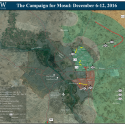 |
 |
The Campaign for Mosul: December 6-12, 2016

The Iraqi Security Forces (ISF) made significant gains in northeastern Mosul from December 6 to 12, but struggled to advance in the southeast. The ISF ordered a change in tactic on December 4 in order to address the lopsided eastern offensive, attempting to make rapid advances in the southeast rather than grind through neighborhood-by-neighborhood clearing operations. The shift, however, failed drastically when the rapid gains left the ISF open to ISIS counterattacks, resulting in heavy casualties on December 6 and 7. In response, the ISF moved units previously allocated to breach Mosul’s southwestern neighborhoods to reinforce efforts in the southeast on December 10.
The Iraqi Security Forces (ISF) pushed to accelerate and complete operations in eastern Mosul from December 6 to 12 in order to reach the Tigris River and launch an offensive into western Mosul as the second month of the operation comes to an end. Efforts in the southeast, largely under the command of the Iraqi Army, however, have struggled to match efforts in the northeast, led by the elite Counter Terrorism Forces (CTS).
The CTS, with the support the 16thIraqi Army Division entering from the north, made significant gains in northeastern Mosul from December 6 to 12. These gains have been the result of weeks of intensive and difficult block-by-block clearing operations. The CTS used this tactic in operations in Ramadi and Fallujah; it is not having the same level of effectiveness in Mosul as it did before, largely due to the dense civilian population remaining in the city whom ISIS has used as human shields. As a result the CTS requires additional time to advance, but it is still able to make gains against ISIS because of its superior skills and experience in urban warfare.
In the southeast quarter, the less experienced Iraqi Army has not been able to overcome ISIS’s resistance by grinding through block-by-block. As a solution, the ISF ordered a change in tactic on December 4, calling for “surprise” operations that would seek rapid extensions into ISIS-held areas. The tactic was put to the test on December 6, when a unit from the 9th Iraqi Army Armored Division made a quick offshoot west in order to retake the Salaam Hospital, near the bank of the Tigris River. The move, however, left the ISF open to ISIS counterattacks and ISIS, hidden in the area, launched a massive ambush on the unit on December 6 and 7. The failure required a Coalition airstrike and a rescue by the CTS to extract the unit on December 7, which reported one hundred casualties.
The ISF and Coalition are now focusing efforts in the southeast in order to accelerate the entire eastern operation. The ISF moved three brigades from the 5th Federal Police Division, or roughly 4,000 men, from the southern axis to reinforce the ISF in the southeast on December 10. These forces, previously allocated to spearhead operations into the Mosul airport and military base, will reportedly operate in the same neighborhood of the failed hospital offensive. They are currently mobilizing in Hamdaniya, southeast of Mosul, before they move into the city itself. Additionally, sources reported that a Coalition airstrike targeted the fifth and final bridge connecting east and west Mosul. The destruction of the bridge will reduce ISIS’s ability to transport equipment and people into eastern Mosul and will help anti-ISIS forces box in remaining ISIS militants in order to advance west. If the ISF can succeed in pushing ISIS out of southeastern Mosul, forces in the southeast may move to breach Mosul’s airport and military base from the east where it could establish a forward operating base for further operations into western Mosul.